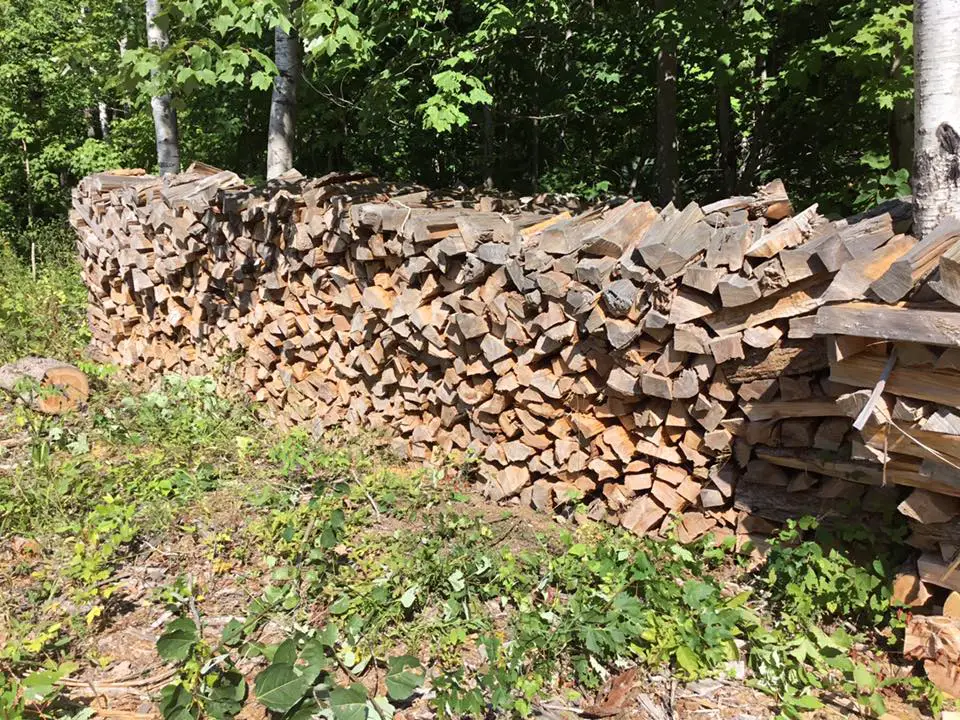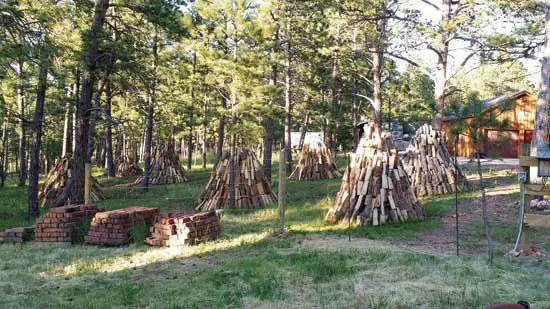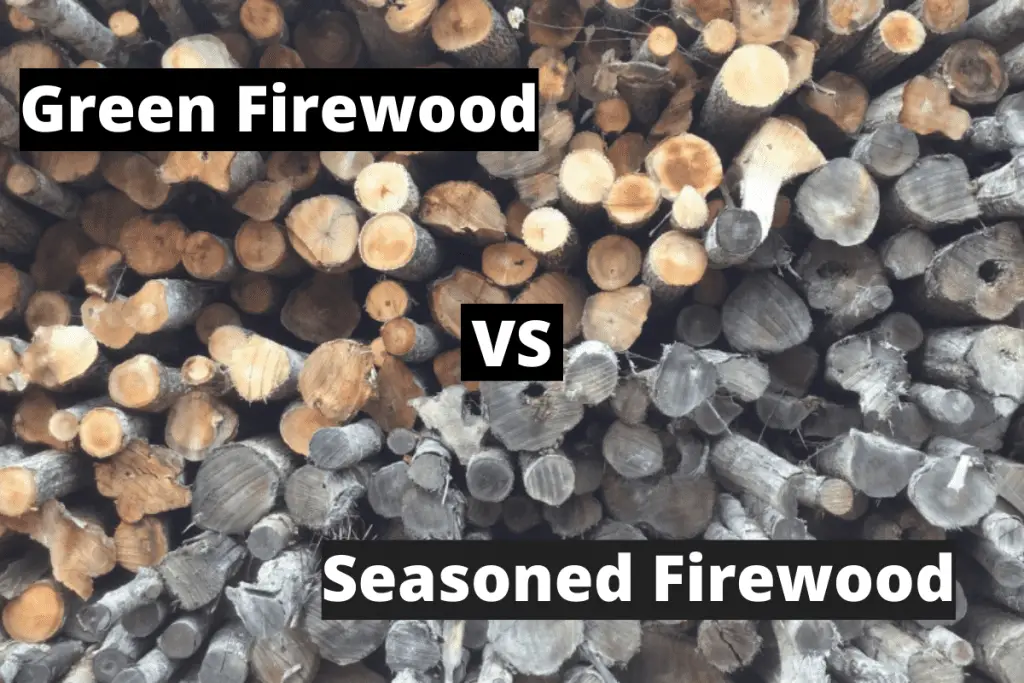Seasoned firewood is wood that has been dried to remove its moisture. When wood is cut fresh, it contains a lot of water inside the wood fibers, which makes it difficult to burn. Seasoned firewood is dry, burns much more easily, and generates more heat.
Here is your guide to everything you need to know about seasoned firewood.
If you are looking for a step-by-step guide on how to season firewood efficiently, I have put together this guide for more information.
Table of Contents
What is Seasoned Firewood?
Seasoned firewood is dried wood. The drying process prepares the firewood for burning. It is called ‘seasoned’ because it has been drying for over a ‘season.’
Freshly cut wood (aka green wood), contains a lot of moisture – up to 50%. Wood is hygroscopic, which means that it can absorb water. Plus, some tree species contain internal sap and other sources of moisture. Seasoning is the process that removes this moisture and turns green wood into something that you can burn more efficiently.

the Drying Process
The drying process removes moisture from freshly cut firewood to prepare it for burning. Here’s how the drying process works.
Moisture is naturally present in the cells of freshly cut wood and can affect the burning quality of the firewood.
Over time, the sun and wind will evaporate the moisture in the firewood. This can take several months to a year or more, depending on the type of wood, the humidity, and other environmental conditions.
Sap is a sticky substance in the cells of freshly cut wood and can make it difficult to burn. Over time, the sap in the wood will dry out and become less sticky, making it easier to burn.
Dry wood burns hotter and produces fewer particulates, making it easier to light and safer to use.
Moisture can also be reabsorbed back into the wood, so protect your dry wood from rain.

Hardwood vs Softwood
Hardwood and softwood take different amounts of time to season because of their distinct physical and chemical characteristics. Here’s why:
Density
Hardwoods are denser than softwoods and have smaller, more tightly packed cells. This means it takes longer for moisture to evaporate from hardwoods, as less surface area is exposed to the air. As a result, hardwoods typically take longer to season than softwoods.
Resin content
Softwoods contain more resin than hardwoods, making them more difficult to dry. Resin is a sticky substance that can make the wood more resistant to moisture evaporation and contribute to creosote buildup in chimneys.
Moisture content
The initial moisture content of the firewood can also affect the seasoning time. Freshly cut firewood can contain up to 50% or more moisture, which must be removed before the wood is ready to burn. Woods with higher moisture content will take longer to dry than woods with lower moisture content.
It’s important to note that the seasoning time can vary depending on environmental conditions, such as temperature, humidity, and air flow.
Hardwoods generally take 6 to 12 months to season, while softwoods take 3 to 6 months to season.
It’s also important to store seasoned firewood in a covered, dry place to prevent it from reabsorbing moisture.
Check the Moisture Content
You can judge the moisture content of your firewood by eye, but the more accurate method is to use a moisture meter device. Let’s have a look at some ways of checking whether your wood is dry enough to burn.
Check With a Moisture Meter
Depending on the wood type, it will take different lengths for your wood to season. A moisture meter is the best way to tell if your wood is seasoned. A moisture meter is an instrument that measures the moisture content of the wood. To use a moisture meter, insert the prongs into the wood and look at the display reading. Ideally, firewood should contain less than 20% moisture.
I personally recommend this General Tools Moisture Meter. It allows you to accurately gauge how wet your firewood is and whether it is sufficiently seasoned. Over time you can also see how quickly the moisture is dropping and how much longer you need to keep your firewood dropping until it is seasoned and ready to burn.
Press the sharp pins into the wood and you will quickly see the readout show the moisture ranging from 5% to 50%. It also has a Low/Mid/High indication depending on whether the wood is dry enough, so you don’t need to remember the actual values.

Check Without a Moisture Meter
You can’t always have a moisture meter on hand, but luckily you can tell if the wood is seasoned enough without it. If the wood is pale in color, noticeably lighter than fresh-cut wood, flaking, or sounds hollow, then it is seasoned.
The sound test is a simple and effective method for checking if firewood is seasoned. To perform the sound test, you tap two pieces of firewood together and listen for the sound they make. Here’s how it works:
- Tap two pieces of firewood together: Hold one piece in each hand and tap them together.
- Listen for the sound: If the firewood is seasoned, you should hear a dull thud when you tap the pieces together. If the firewood is not seasoned, it will make a higher-pitched, resonant sound.
The sound test works because seasoned wood is denser than unseasoned wood. As the firewood dries, the moisture inside the wood evaporates, making the wood denser and less likely to produce a resonant sound when tapped.
You can always try setting a piece on fire to test it. If it burns cleanly without smoldering, your wood is seasoned enough.

Benefits of Burning Seasoned Firewood
Burning seasoned firewood has significant advantages over burning green wood.
Improved Combustion
The first point to consider when discussing the benefits of seasoned firewood is improved combustion. Seasoning wood decreases its moisture content, making it burn more efficiently. This efficient combustion process reduces the amount of smoke produced during burning. Besides being a nuisance, smoke can be hazardous, containing particles that can cause health issues.
Therefore, with its reduced smoke emission, seasoned firewood is more effective for generating heat and healthier to use.
Better Heat Output
The heat output from seasoned firewood is significantly superior to its unseasoned counterparts. Dry wood burns at a higher temperature, which means you get more heat from a given amount of wood.
This attribute is particularly beneficial in colder climates or during winter months, where a warmer fire is appreciated. By providing more heat per log, seasoned firewood also turns out to be a more economical choice.
Longer Burn Time
An additional advantage of seasoned wood is its longer burn time. Unlike freshly cut, ‘green’ wood, seasoned firewood burns longer, making it more convenient and cost-effective.
The longer burn time means less frequent tending to the fire, which can be especially beneficial for overnight heating or long, relaxing evenings by the fire.
Less Creosote Buildup
Furthermore, seasoned firewood contributes to safer burning practices by reducing creosote buildup. Creosote is a byproduct of burning unseasoned or ‘green’ wood, and it tends to accumulate in chimneys, potentially leading to dangerous chimney fires.
By using seasoned wood, you can minimize the risk of creosote buildup, making your fire-burning practices safer and more responsible.
Improved Air Quality
Air quality around your fire is also significantly improved when using seasoned firewood. Burning dry wood produces fewer particulates – tiny bits of solids or liquids that are released into the air. These particulates can be harmful when inhaled, especially for people with respiratory issues.
Using seasoned wood ensures that you and your loved ones breathe cleaner air when enjoying the warmth of the fire.
Smoke Reduction
One of the noticeable benefits of seasoned firewood is the reduction in smoke. This is primarily due to the lower sap content in seasoned wood. Sap, when burned, generates a significant amount of smoke.
With its lowered sap content, seasoned wood produces less smoke, making the burning process more pleasant and reducing possible eye or throat irritation caused by heavy smoke.
Final Thoughts
Seasoning wood dries out the moisture and makes green wood easy and pleasant to burn. Seasoning wood takes time, but it is a hands-off process if you stack it properly and keep it away from the rain.
